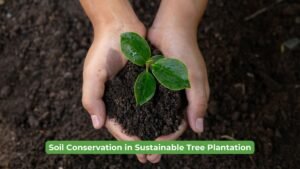In an era where environmental conservation is not just a necessity but a critical imperative, the advent of Tech-Driven Tree Plantation offers a glimmer of hope.
How can we leverage the power of advanced technologies to counteract deforestation?
Can artificial intelligence (AI) and Drones become the game-changers in the field of afforestation?
The year 2024 marks a significant turning point in how technology, particularly AI and drones, is revolutionizing the approach to tree plantation.
This journey into tech-driven tree plantation highlights technological innovation and sets a standard for future environmental restoration efforts.
The Emergence of AI in Afforestation

Artificial Intelligence has carved its niche in various sectors, and afforestation is no exception.
AI-powered satellite image analysis is revolutionizing deforestation monitoring.
Advanced algorithms can analyze vast amounts of satellite imagery to identify and map areas of deforestation in near real time.
This real-time data is crucial for informing conservation efforts and enabling timely interventions to prevent deforestation.
AI is also being used to develop predictive models of deforestation.
These models can identify areas at high risk of deforestation based on factors such as land use patterns, population density, and infrastructure development.
AI’s role in enhancing tree plantation efforts is multifaceted, encompassing data collection, analysis, and implementation of plantation strategies.
Through sophisticated algorithms, AI systems can analyze vast amounts of environmental data, including soil type, climate conditions, and land topography.
This analysis helps in determining the most suitable species of trees for specific areas, optimizing water use, and predicting the growth patterns of planted saplings.
Furthermore, AI facilitates the monitoring of tree health and growth, enabling timely interventions to ensure survival and thriving ecosystems.
The integration of AI in afforestation projects has led to the development of smart forestry management systems.
These systems provide actionable insights for effective plantation strategies, ensuring higher success rates and sustainability.
AI-driven technologies empower stakeholders to make informed decisions, contributing to the global efforts of restoring forest cover and combating climate change.
The Role of Drones in Tree Plantation

Drones, or unmanned aerial vehicles (UAVs), have become indispensable tools in modern afforestation efforts.
With high-resolution cameras, drones provide a bird’s-eye view for efficient, cost-effective surveys of vast terrains, outpacing traditional methods.
This capability is particularly beneficial for identifying deforested or degraded areas that are prime candidates for reforestation.
Beyond surveying, drones are revolutionizing the actual process of tree planting.
Drone technology enables the aerial seeding of thousands of seed pods in a single day, covering large areas efficiently and effectively.
These seed pods are designed to protect the seeds from predators and provide essential nutrients for early growth stages.
Drone-assisted planting ensures a higher germination rate and survival chances for the saplings, significantly accelerating the afforestation process.
Drones enable precise seed dispersal, allowing for custom planting patterns and densities suited to the area’s environmental needs and goals.
This level of accuracy and efficiency in tree planting is unprecedented and marks a significant advancement in afforestation techniques.
Role of Drones in Tree Plantation
1. High-Efficiency Planting
Drones are capable of planting thousands of seeds per day, significantly outpacing the speed of manual planting efforts.
Equipped with specialized seed pods, drones can target specific locations with high precision, ensuring that seeds are delivered to the most suitable planting sites.
This efficiency not only accelerates the planting process but also allows for the coverage of larger areas in shorter timeframes.
2. Access to Inaccessible Areas
One of the most significant advantages of using drones is their ability to reach remote or difficult-to-access areas.
This capability is particularly beneficial for planting trees in rugged terrains, dense forests, or regions affected by natural disasters.
Drones excel in planting seeds in hard-to-reach areas, reducing the need for risky and labor-intensive human efforts.
3. Reduced Labor and Costs
The use of drones in tree plantations can lead to substantial reductions in labor requirements and associated costs.
By automating the planting process, the need for large teams of workers to physically plant seeds is greatly diminished.
This automation not only makes the process more cost-effective but also reduces the environmental footprint associated with human travel to planting sites.
4. Precision in Planting
Drones are not just about spreading seeds randomly; they are equipped with advanced technologies such as GPS and mapping software.
This allows for precise planting, with drones being able to deposit seeds at specific locations and optimal depths.
Such precision enhances the likelihood of seed germination and survival, leading to more successful reforestation efforts.
5. Environmental Monitoring and Data Collection
Beyond planting, drones play a crucial role in monitoring the environment and the progress of reforestation projects.
They can be equipped with cameras and sensors to collect data on soil quality, moisture levels, and plant health.
This information is invaluable for adjusting planting strategies, ensuring the well-being of newly planted trees, and assessing the overall success of reforestation initiatives.
The Synergy of AI and Drones in Tech-Driven Tree Plantation

AI and drone technology are transforming tech-driven tree plantations, ushering in unmatched precision, efficiency, and commitment to the environment.
This synergy offers unparalleled advantages in enhancing reforestation efforts, making the process smarter, faster, and more adaptable to the challenges of climate change.
The combination of AI and drones represents a powerful synergy that is pushing the boundaries of traditional afforestation methods.
AI algorithms optimize the flight paths and planting patterns of drones, ensuring maximum coverage and seed survival rates.
AI-driven data analysis enables ongoing monitoring and management of new plantings, guiding adjustments for better growth and resilience.
This tech-driven approach to tree plantation is not only more efficient but also more sustainable.
AI and drones reduce human intervention and optimize resources, preserving habitats and cutting carbon footprints from traditional planting.
The Impact of Tech-Driven Tree Plantation in 2024

In 2024, the impact of tech-driven tree plantation is evident in the increased scale and success rates of afforestation projects worldwide.
Technological advancements have facilitated the planting of millions of trees, notably aiding land restoration and climate change mitigation.
Tech-driven precision and efficiency have spurred collaboration among governments, NGOs, and the private sector, propelling global reforestation.
Furthermore, the data collected and analyzed through AI and drone technologies provide valuable insights into the effectiveness of different afforestation strategies.
This knowledge base fuels ongoing innovation, setting the stage for more ambitious and successful future tree plantation projects.
Engaging the Future
At the intersection of environmental sustainability and technological progress, the critical need for innovative solutions like tech-driven tree plantation is clear.
The successes of 2024 serve as a testament to the potential of AI and drones in transforming afforestation efforts.
However, the journey does not end here.
It requires the collective effort of governments, private entities, environmental organizations, and individuals to continue pushing the boundaries of what is possible.
The call to action is clear: Let us leverage the power of technology to restore our planet’s green cover.
By supporting and investing in tech-driven tree plantation projects, we can contribute to a sustainable future for generations to come.
Whether you are a policymaker, an environmental activist, or simply an individual concerned about our planet’s future, your involvement can make a difference.
As we look forward to the innovations and advancements that the future holds, let us remain committed to the cause of afforestation.
Collaboration and ongoing use of AI and drones can help us meet global reforestation targets and fight climate change effects.
In embracing tech-driven tree plantation, we not only preserve the environment but also pave the way for technological innovations to flourish in service of the earth.
The future is green, and together, we can ensure it stays that way.
Conclusion
The year 2024 has been a pivotal one for afforestation, showcasing the remarkable capabilities of AI and drones in revolutionizing tree-planting efforts.
As we continue to explore and expand these technological frontiers, let us also remember the ultimate goal: a healthier, greener, and more sustainable planet for all.
The journey of tech-driven tree plantation is just beginning, and its success depends on our collective action and commitment.
FAQs on Tech-Driven Tree Plantation
Q: How does AI contribute to afforestation?
A: AI contributes to afforestation by analyzing environmental data to determine the best tree species for planting, optimizing resources, and monitoring tree health and growth patterns for better survival rates.
Q: Can drones plant trees?
A: Yes, drones can plant trees by dispersing seed pods over large areas. This method is efficient, precise, and allows for the planting of thousands of seeds in a single day.
Q: What are the benefits of tech-driven tree plantation?
A: Tech-driven tree plantation offers numerous benefits, including higher efficiency and precision in planting, reduced costs and environmental impact, and the ability to access and reforest inaccessible areas.
Q: Are AI and drones effective in improving the survival rates of planted trees?
A: Yes, AI and drones significantly improve the survival rates of planted trees. AI assists in selecting the most suitable planting sites and tree species, while drones ensure precise seed dispersal and planting patterns that enhance seed germination and sapling growth.
Q: How can communities get involved in tech-driven tree plantation efforts?
A: Communities can get involved by collaborating with organizations that utilize these technologies, participating in data collection and monitoring efforts, and supporting local afforestation projects that employ AI and drone technologies.
Let’s plant the seeds of change together.
Join the movement towards a sustainable future. Support tech-driven tree plantation efforts today and be a part of the change we wish to see in the world.
Written by Priyanka Velhal from Nelda.




